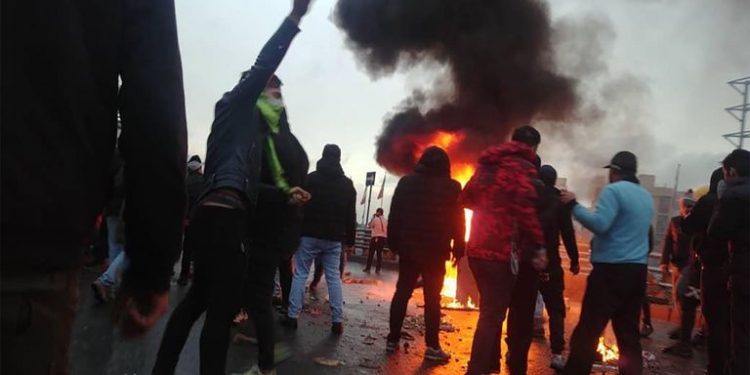TAHRAN
Following a 50% abrupt increase in gasoline prices and a century-long build up of oppression, uprisings errupted in the Islamic Repbulic of Iran where countless gas stations were burnt in protests which spread to 31 cities and 1100 villages.
According to the registered statistics by the Hengaw Human Rights Organisation, 45 Kurdish civilians lost their lives after coming under direct fire of the Iranian Armed Forces while over 500 were injured, during Saturday and Sunday protests, in 14 cities across only Rojhilat (East) Kurdistan.
Despite the country-wide black-out of internet connection and information flow, it has been reported that civilian-deaths have hiked since the attempts to prevent reflection on the international public opinion.
A PLOT TO CLEANSE COUNTRY OF POLITICS?
According to Radio Ferda, broadcasting in Prague on Wednesday, 58 people were killed in the state of Khuzestan as a result of the use of real bullets against demonstrators. Huzistan was the city with the highest number of deaths, while Eastern Kurdistan ranked second with 39 deaths.
In the last week of the clashes and attacks by security forces, 23 people were killed in Kirmanshan, 11 in Sine and 5 in Urmia. The other provinces where the deaths were reported were Persian, Isfahan, Kerman, Tehran, Alborz and Azerbaijan (Tabriz). In total, at least 128 people were killed as reported by Amnesty International.
According to the freedom fighters in exile, at least 251 people were killed, 3,700 people were injured and 7,000 people were taken into custody. The same source shared a list of 85 activists who had been killed amidst the chaos of the riots.
Although the Iranian regime has declared its “victory” against the activists by calling the actions a “conspiracy of the enemy,” demonstrations and internet cuts continue. According to a Persian news agency, Iranian authorities announced that in some areas limited access to the Internet was introduced.
Iran’s National Security High Council announced that in Hürmüzgan, Kirmaşan, Arak, Mashhad, Qom, Tabriz, Hemedan, Bushehr and some districts of Tehran, only home internet lines are enabled. In these regions where the internet lines were limited, access was only permitted to WhatsApp and Instagram as the only social networking sites. It was learned that all phone lines are closed to access.
Ali Rabii, the spokesman of President Hassan Rouhani, announced that interruptions will continue until concerns about Iran’s security are resolved.
THE SIMULATION OF 1988 AND THE CONCERN OF MASS EXECUTION!
Frequent threats by Iranian officials indicate that there will be a tougher orientation towards the actions. Hüsameddin Aşna, the head of Iran’s Strategic Research Center and adviser to the President of Iraq, in a message he published in his social media account, compared the events in Iran to the Furugi Cavidan operation launched by the Mujahideen of the People after the Iran-Iraq War, where many places in Iran were seized.
In Iran, after the Iraq war, the Mujahideen of the People’s Mujahideen launched the Furugi Ashna operation against the Mersad movement of the Iranian regime. With the initiation of this movement, after the rebellion of the Mujahideen people in Iran had become completely suppressed, witch hunting was started and widespread executions took place. According to sources of the People’s Mujahideen, 30,000 members and militants in prisons were executed without trial and arbitrarily in 1988.
Consultant Hüsameddin Aşna stated that those who think that they started the “Furuği Cavidane 2” operation were confronted with the “Mersad 2” operation, indicating that a second execution spree would be launched.
Aşna’s advisor on the social media confirmed the suspicions that a new wave of execution would begin after sharing a post of the Hamaney-based Keyhan newspaper. The title of the post expressed, “prerperations are being made by the leaders of the Islamic Republic of Iran, to sentance the death penalty to those who take part in the gasoline rebellion .”




